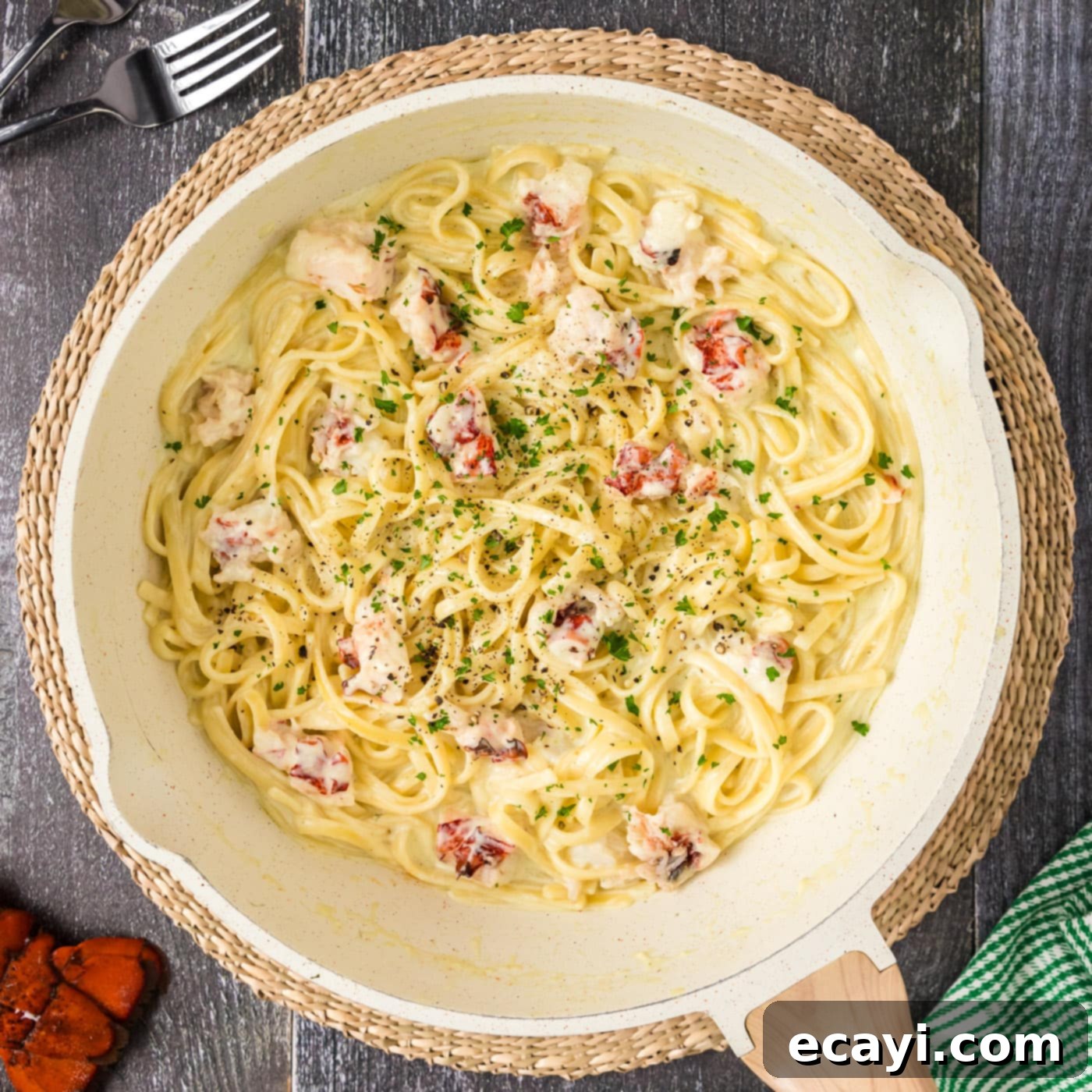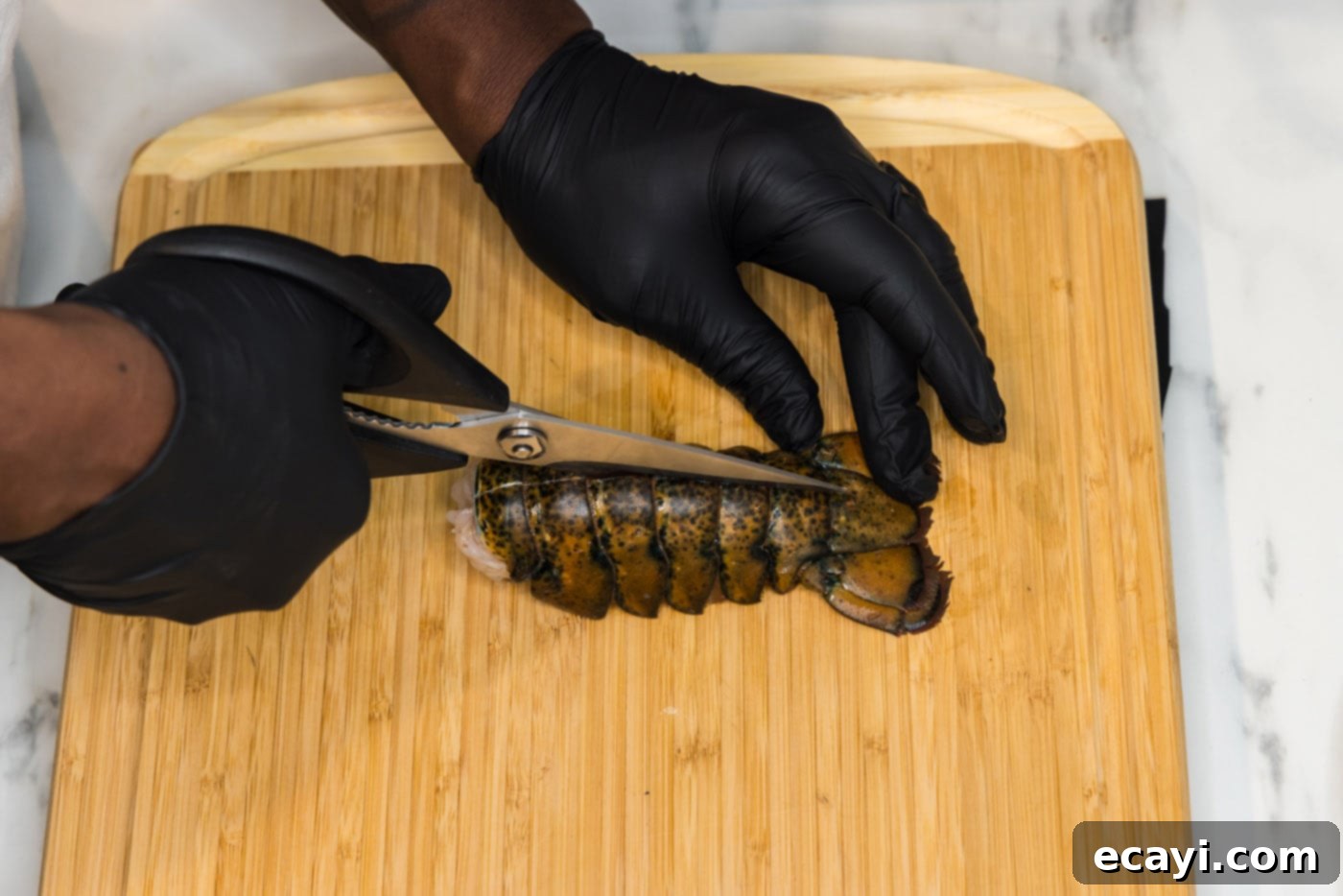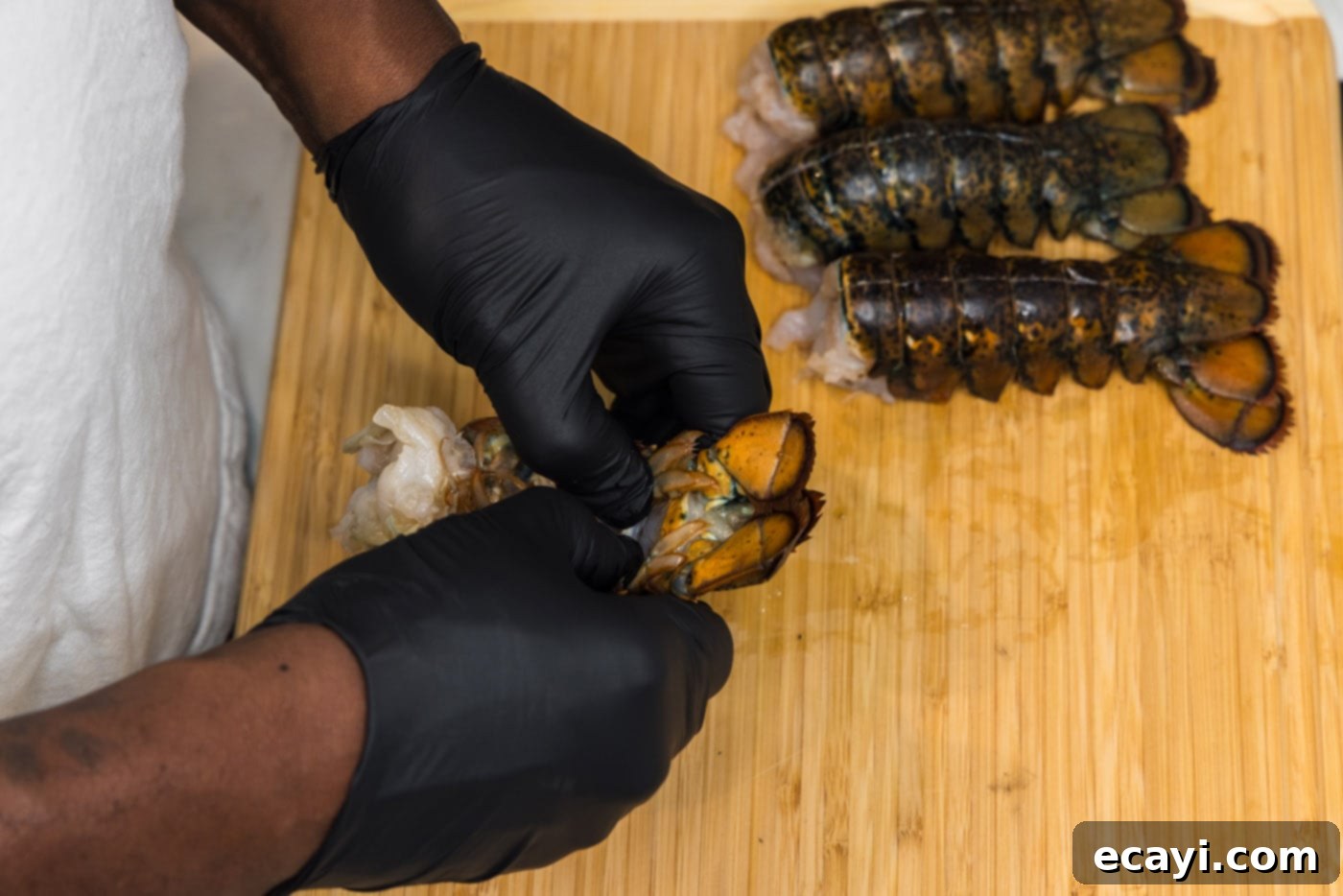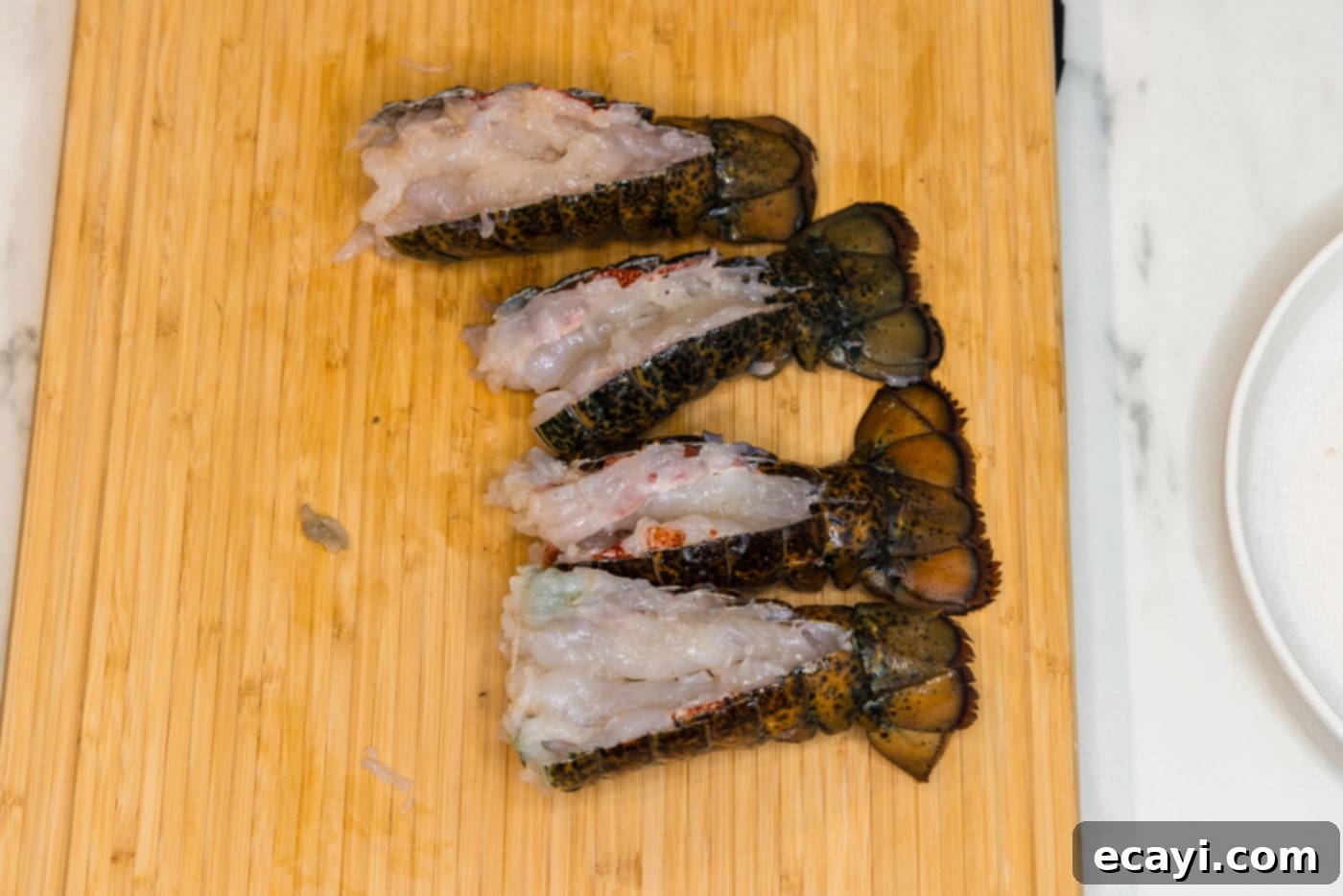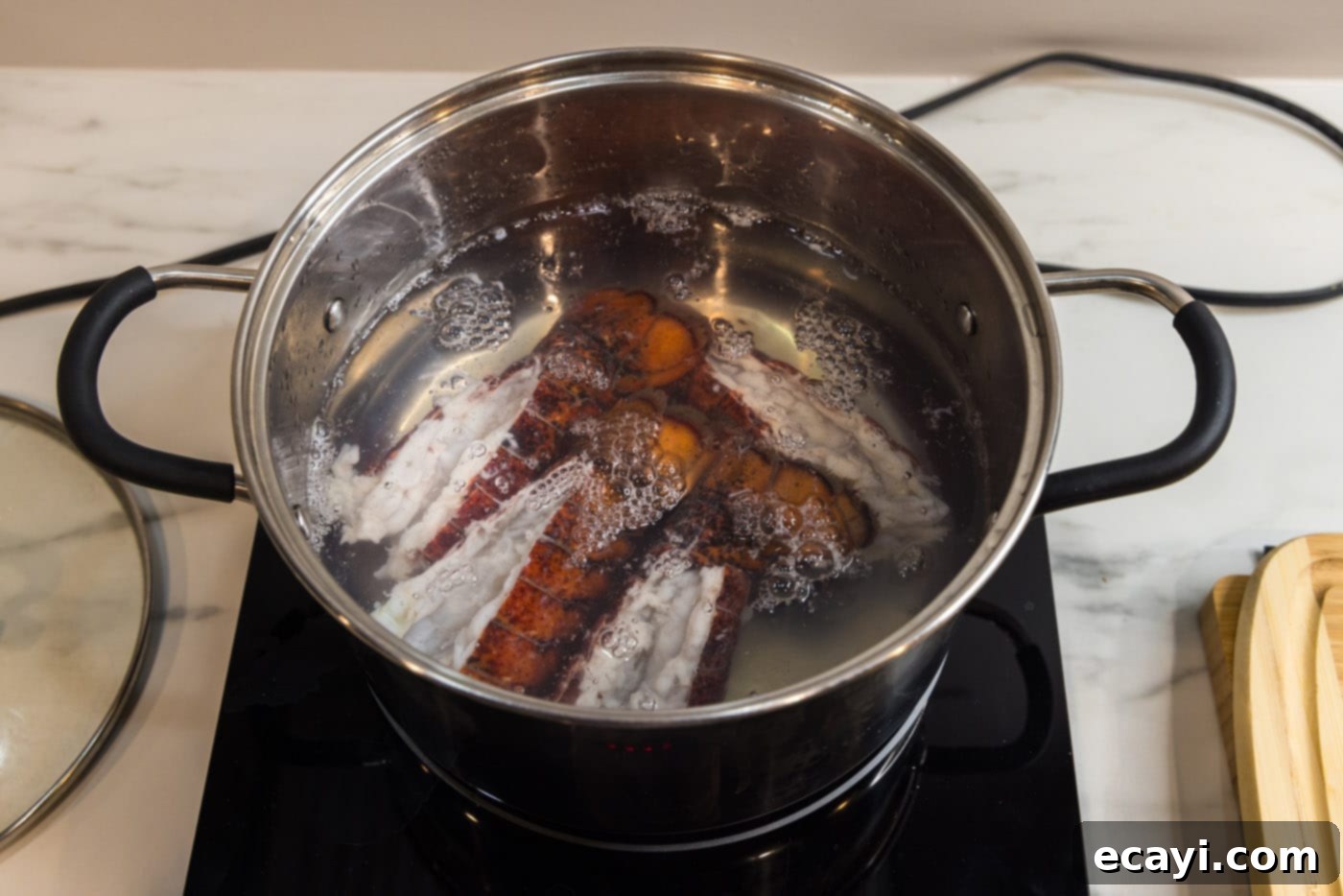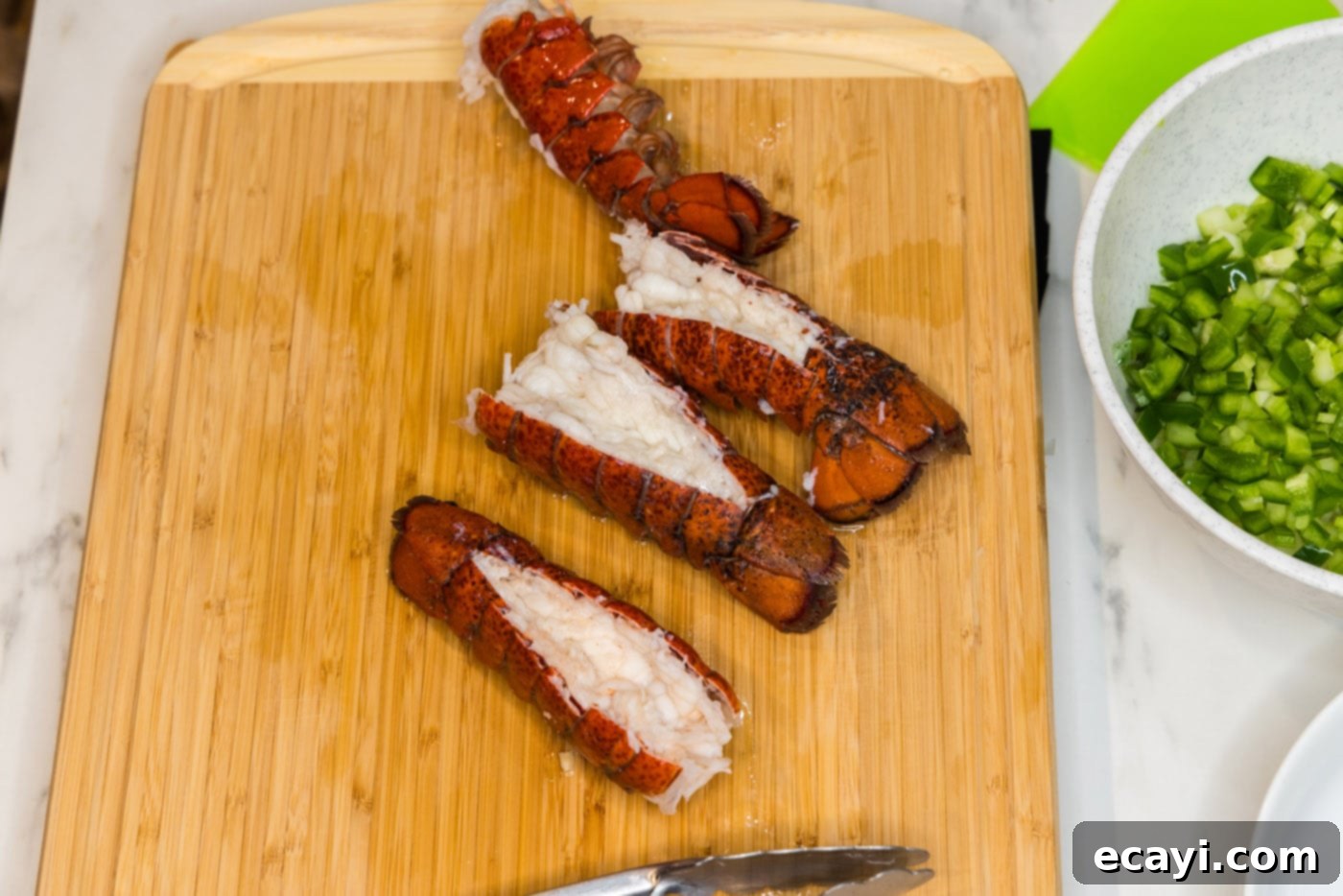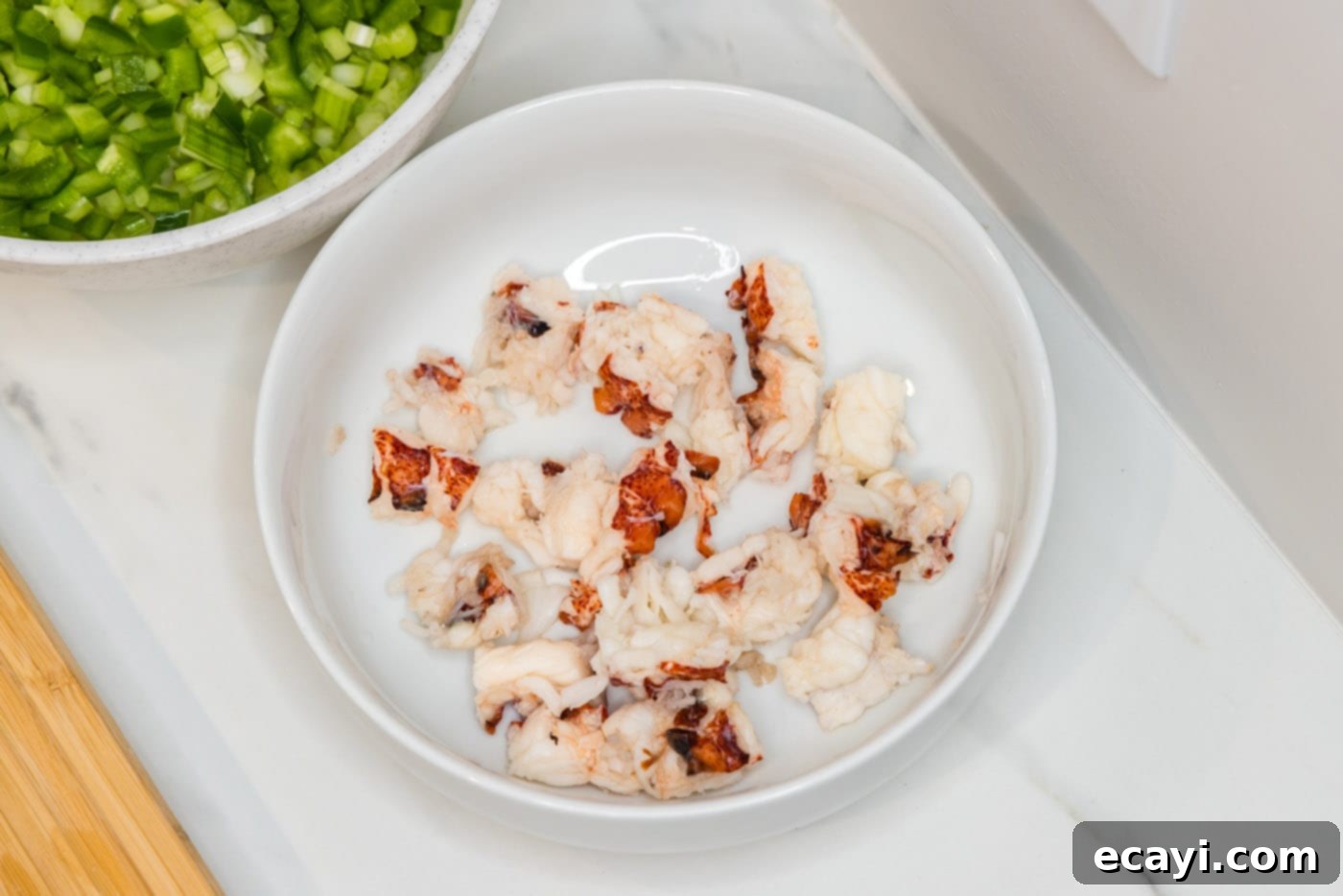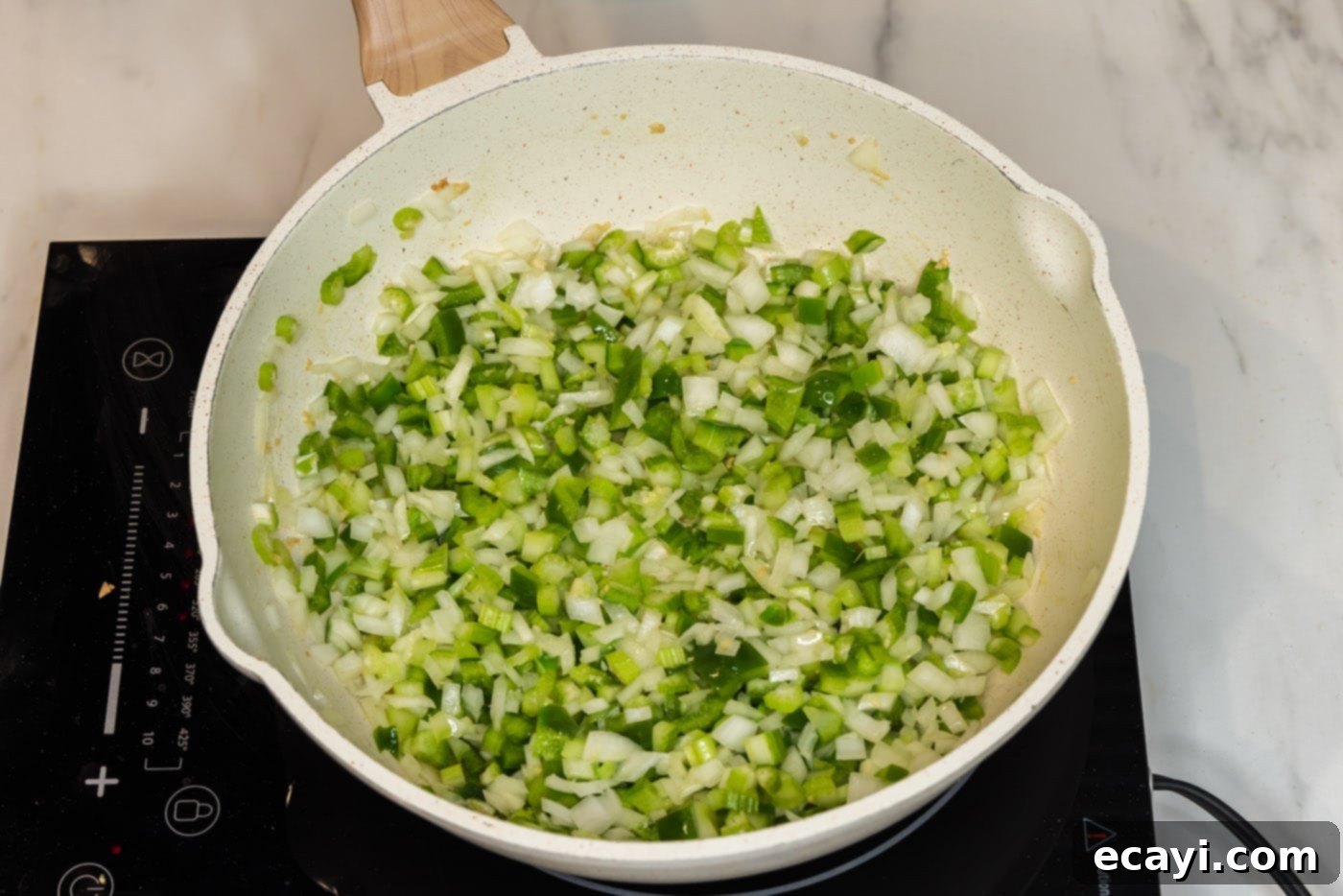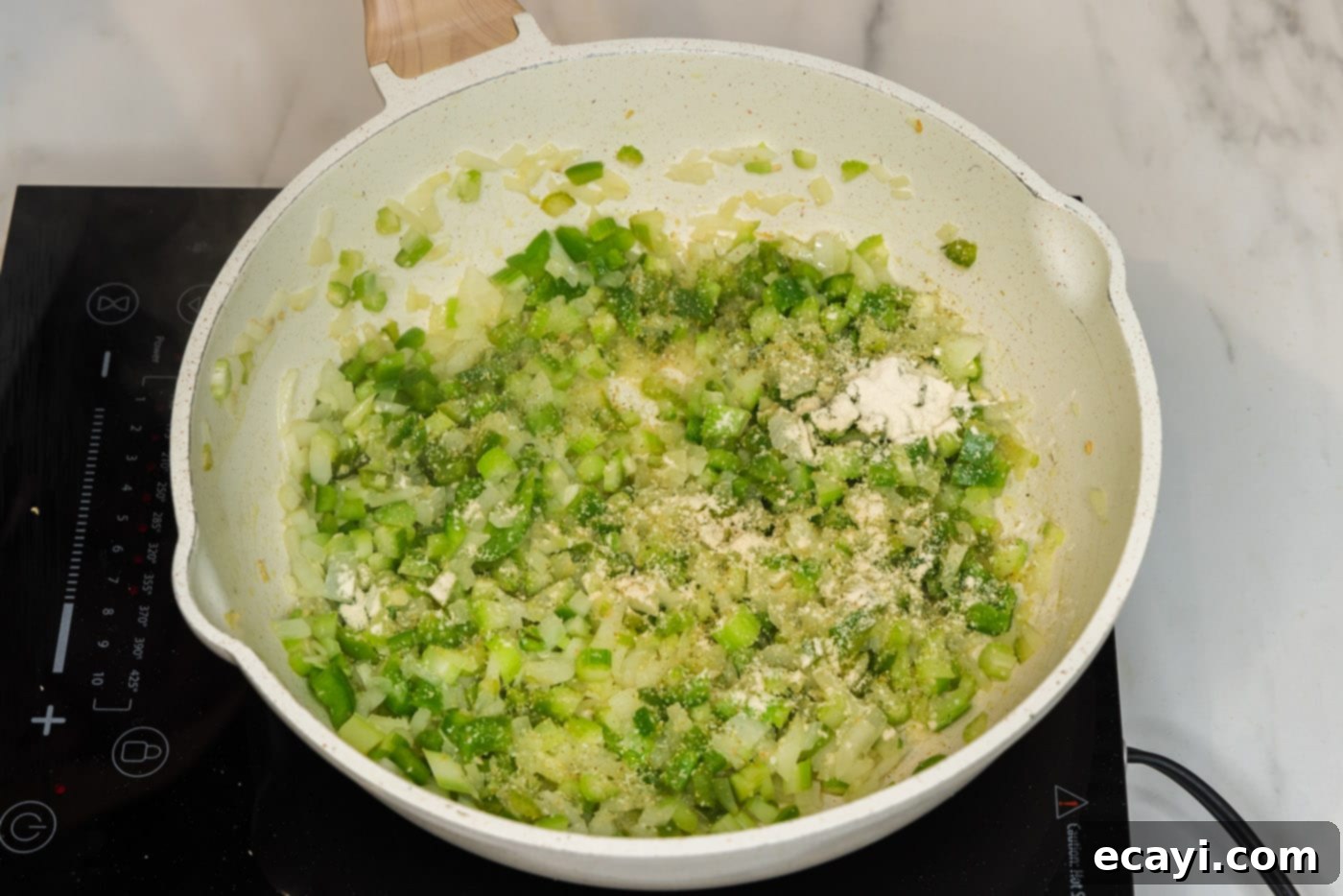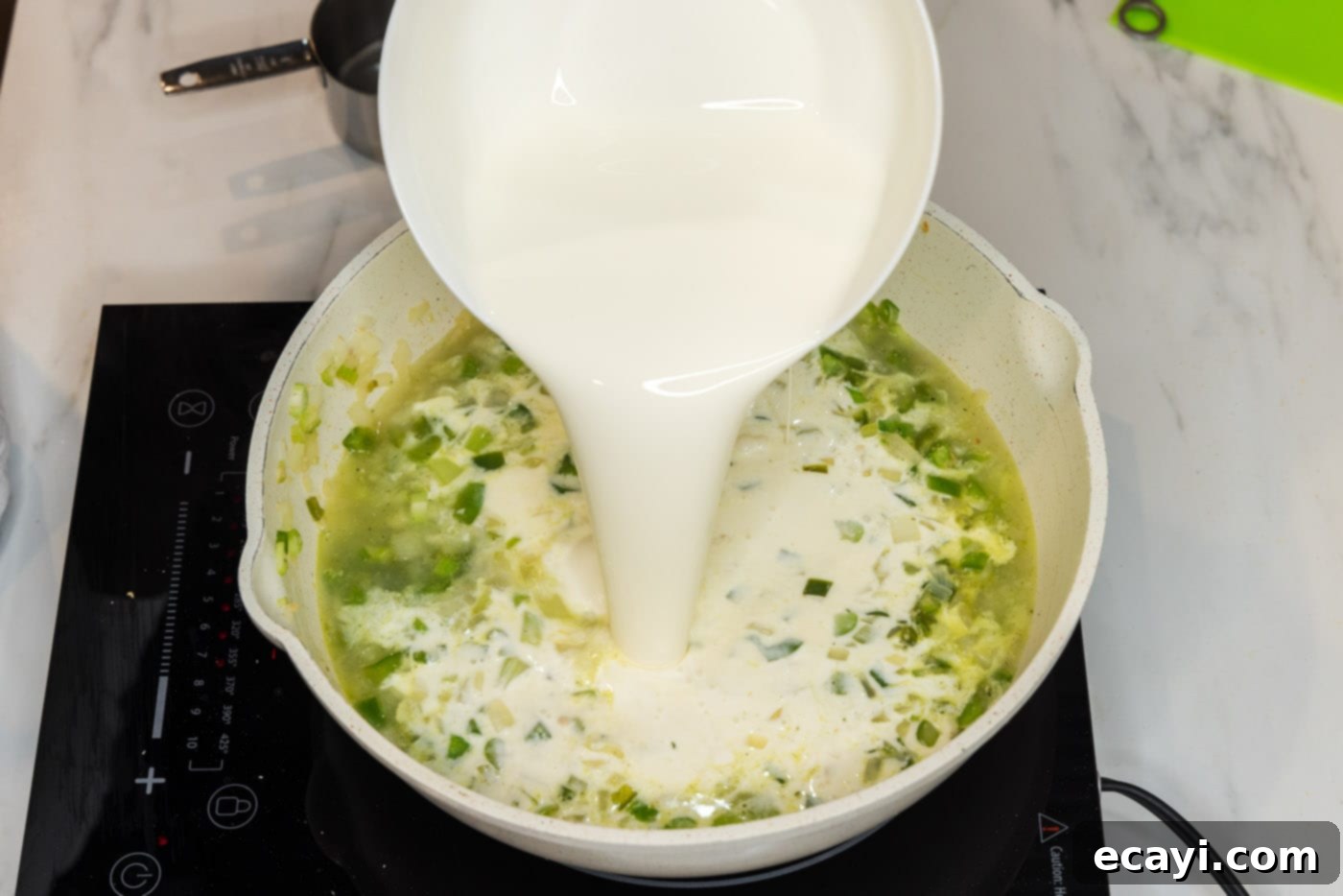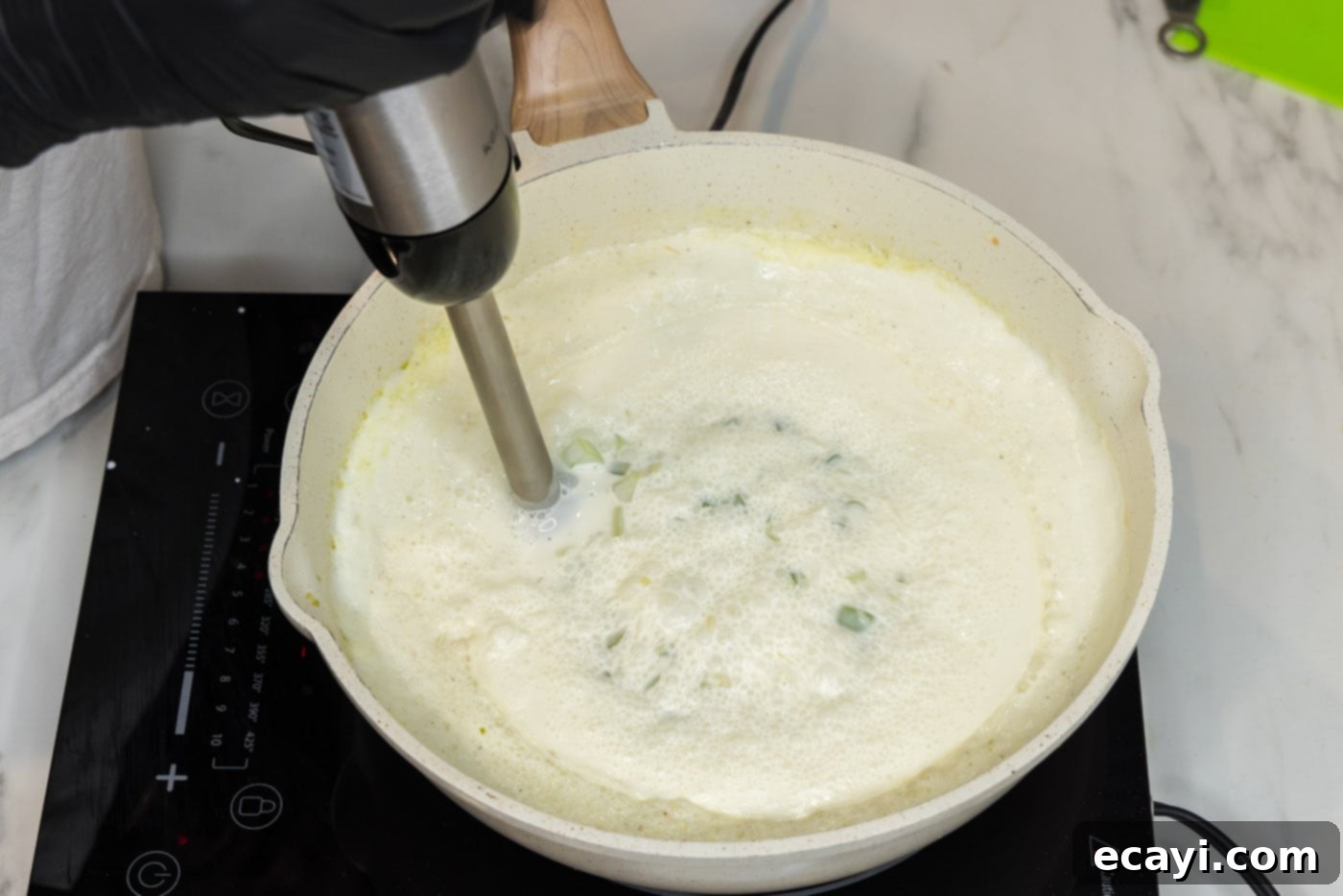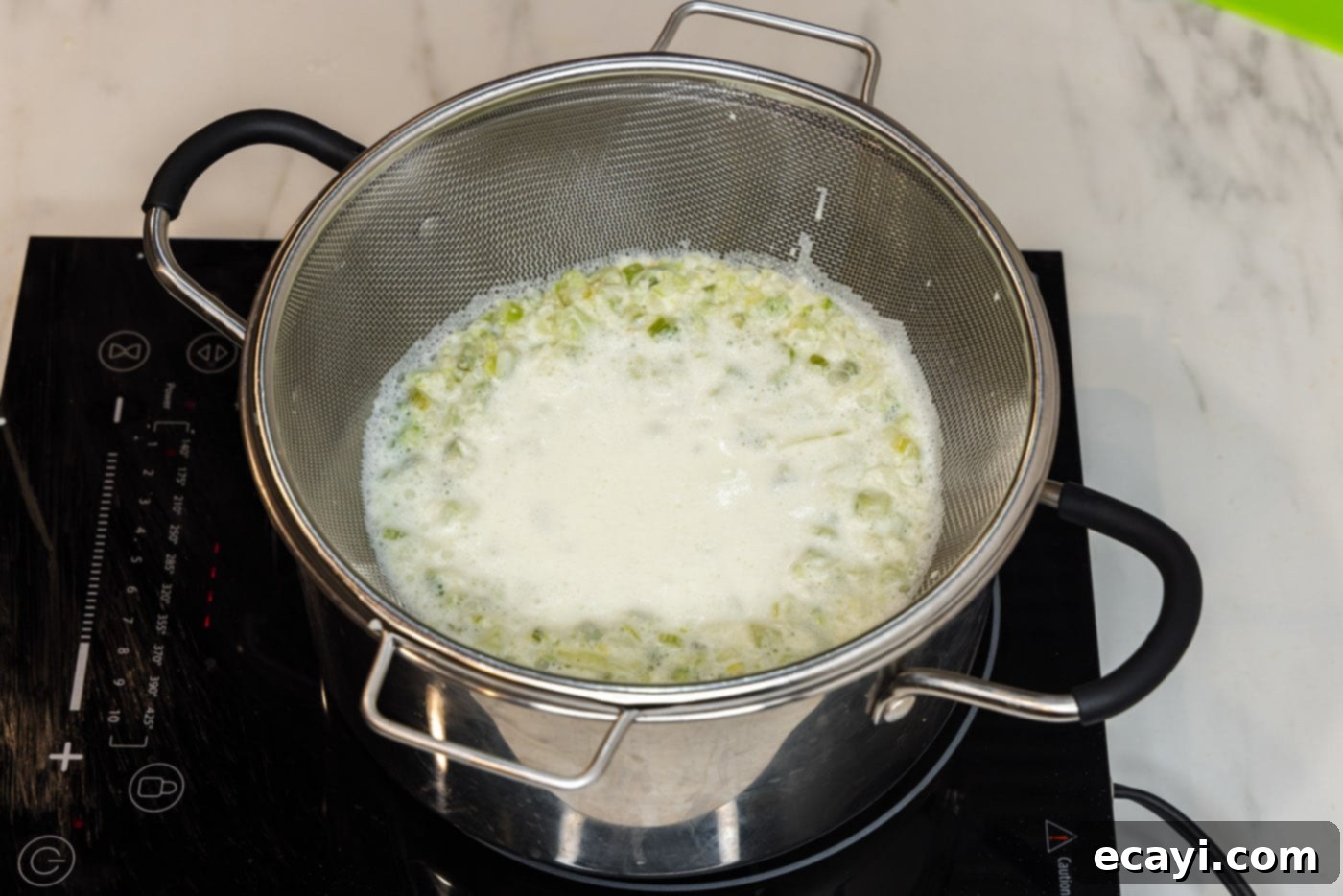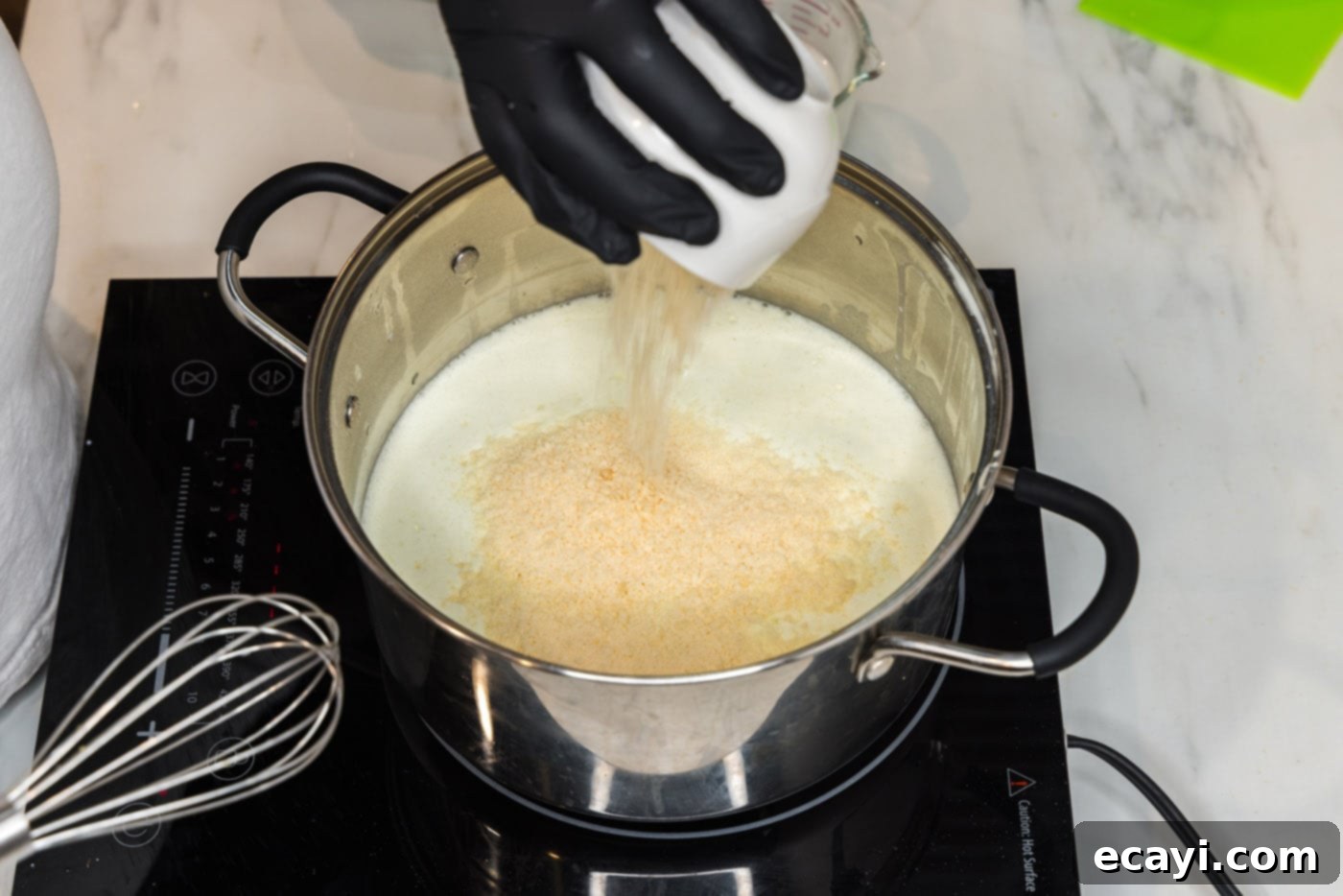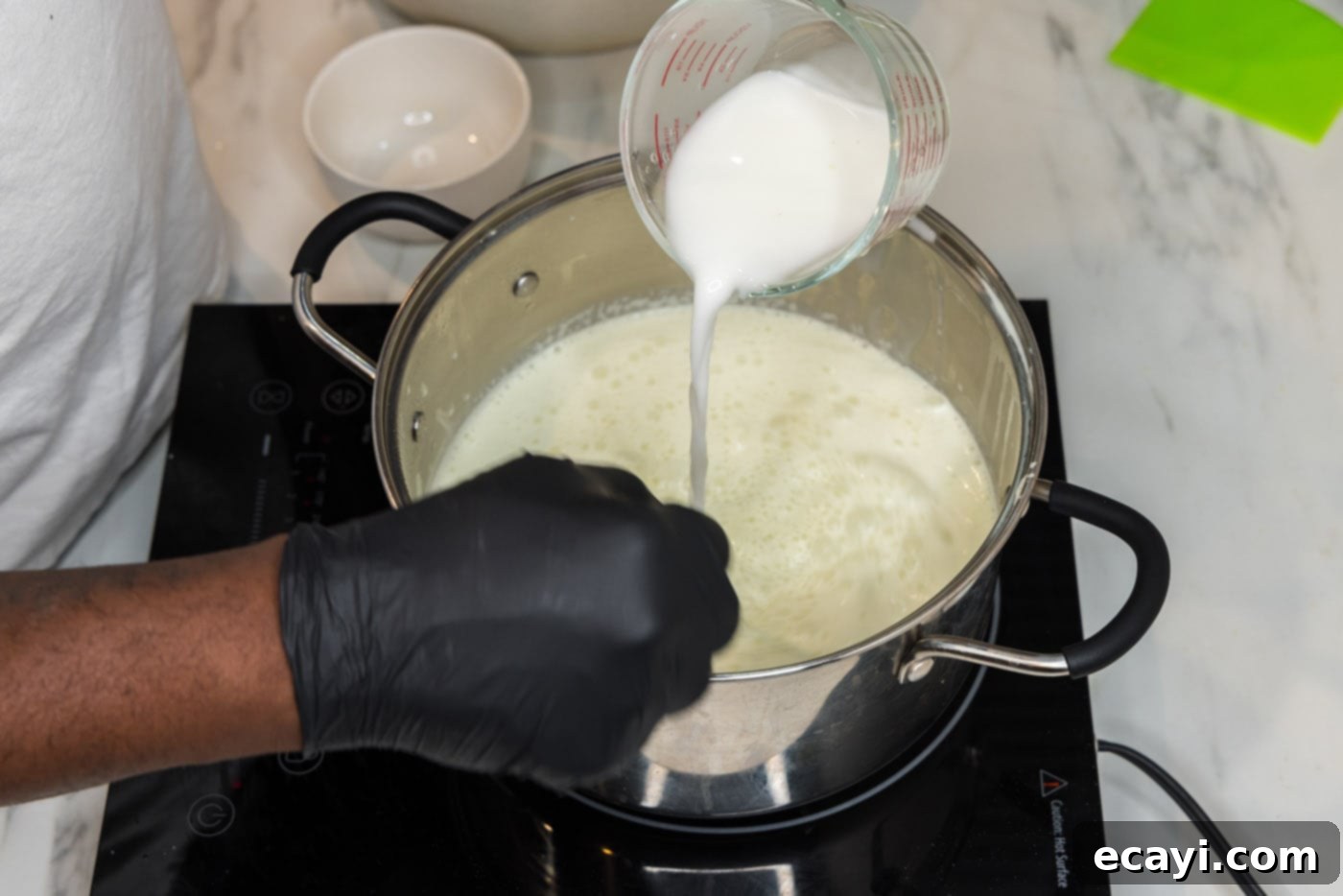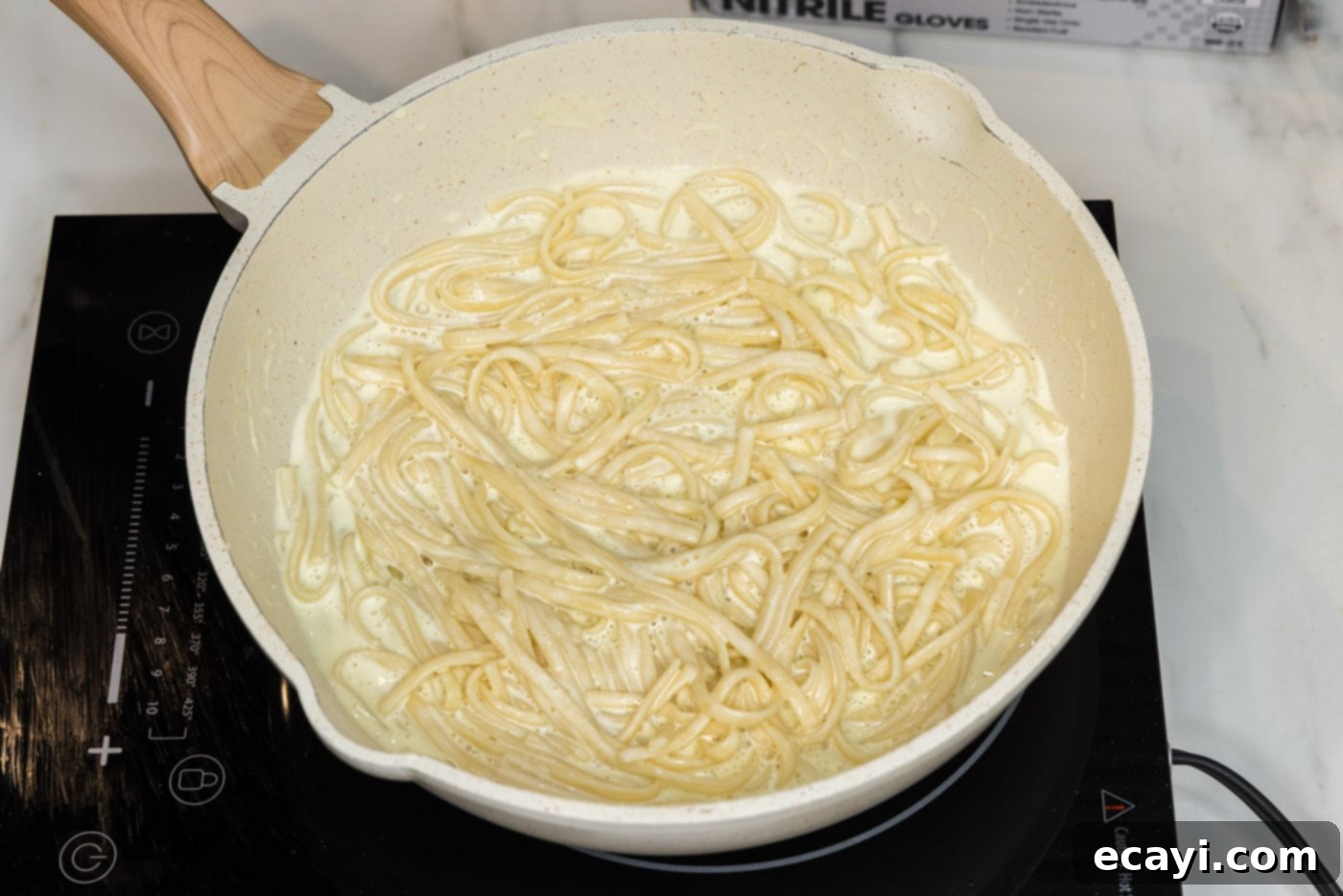Indulgent Creamy Lobster Pasta: A Gourmet Meal Made Easy at Home
Transform any meal into a luxurious dining experience with this incredible creamy lobster pasta recipe. Succulent, tender lobster meat is delicately tossed with al dente linguine and coated in a rich, velvety sauce that promises to delight your senses. This dish, often reserved for upscale restaurants or special occasions, is surprisingly simple to create in your own kitchen, allowing you to enjoy gourmet flavors without the fuss or expense of dining out. Prepare to impress your family and friends with this stunning seafood creation.
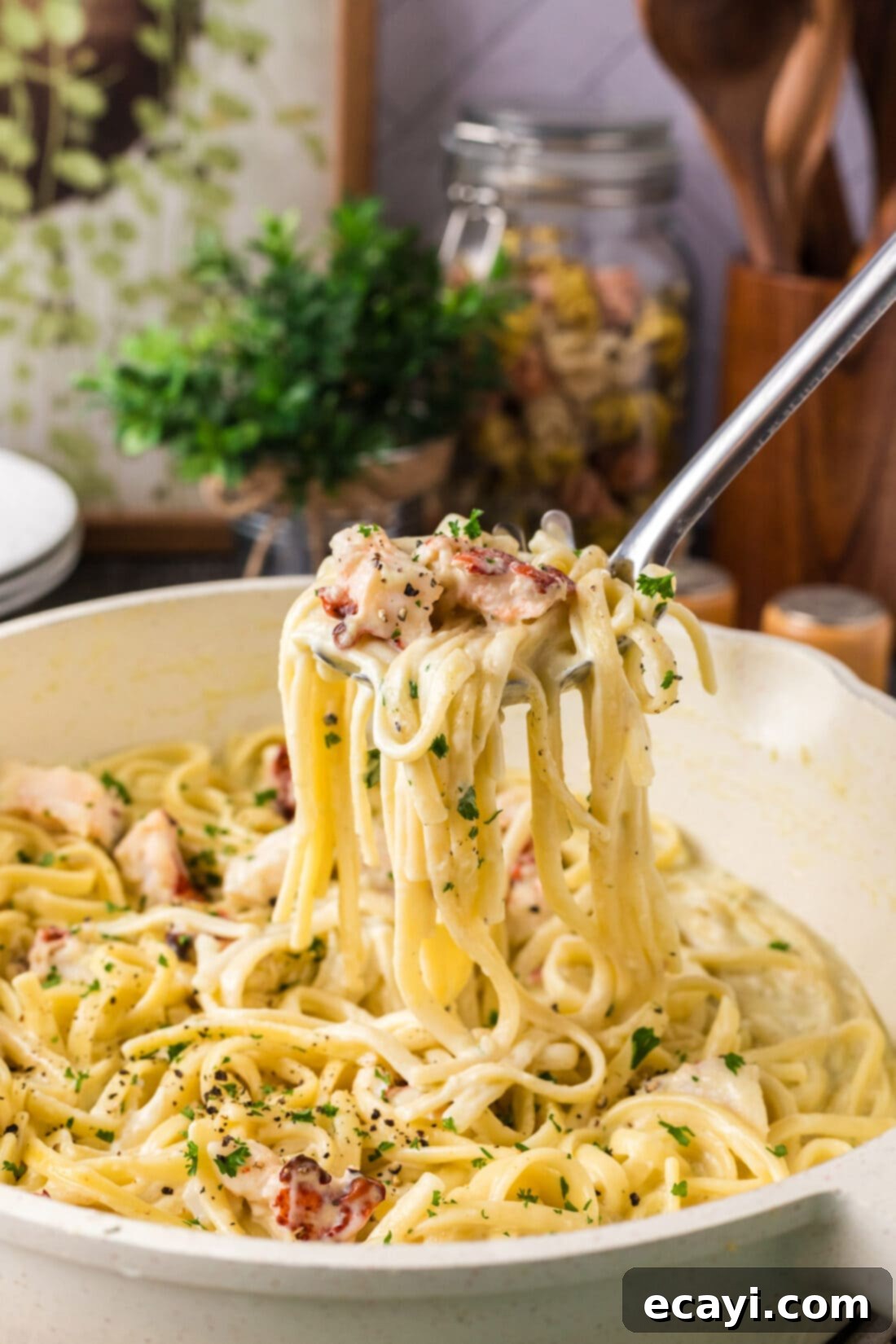
Why This Homemade Lobster Pasta Recipe Works Wonders
While lobster pasta might seem like a complex dish best left to professional chefs, this recipe proves that a truly decadent seafood pasta is well within reach for home cooks. Its brilliance lies in its simplicity and the depth of flavor achieved with minimal effort. Here’s why this recipe will become your new go-to for impressive meals, whether you’re a seasoned cook or looking to venture into gourmet seafood preparation:
- Effortlessly Elegant: Despite its gourmet appeal, the preparation is surprisingly straightforward. We break down the steps into manageable parts, ensuring a stress-free cooking experience even for those new to cooking with lobster. You’ll achieve restaurant-quality results with ease.
- Perfect for Special Occasions or Weeknights: This dish strikes a perfect balance. It’s sophisticated enough for celebrations like Valentine’s Day, anniversaries, or holiday gatherings, yet simple enough to whip together for an indulgent weeknight treat when you’re craving something extraordinary. It elevates any meal without requiring hours in the kitchen.
- Smart Use of Leftovers: If you ever find yourself with extra steamed or baked lobster tails, this recipe offers a fantastic way to repurpose them into an entirely new, exciting meal. No more bland leftovers; transform them into a culinary masterpiece!
- Incredibly Customizable: While linguine is a classic choice for this dish, the recipe is incredibly versatile. You can easily substitute with your favorite pasta shape and adjust seasonings or add-ins to suit your personal palate. This adaptability makes it a forgiving and fun recipe to experiment with.
- Rich and Satisfying Sauce: The heart of this dish is its creamy sauce. Infused with aromatic vegetables and savory seafood stock (derived directly from boiling the lobster!), it forms the perfect luscious embrace for the tender lobster and pasta. The sauce is specifically designed to cling beautifully to every strand, ensuring a burst of flavorful goodness in every single bite.
- Gourmet Flavor, Home-Cooked Comfort: This recipe delivers the rich, luxurious taste you’d expect from a high-end restaurant, but with the comforting warmth and satisfaction of a home-cooked meal. It’s an approachable way to bring a touch of luxury to your dinner table.
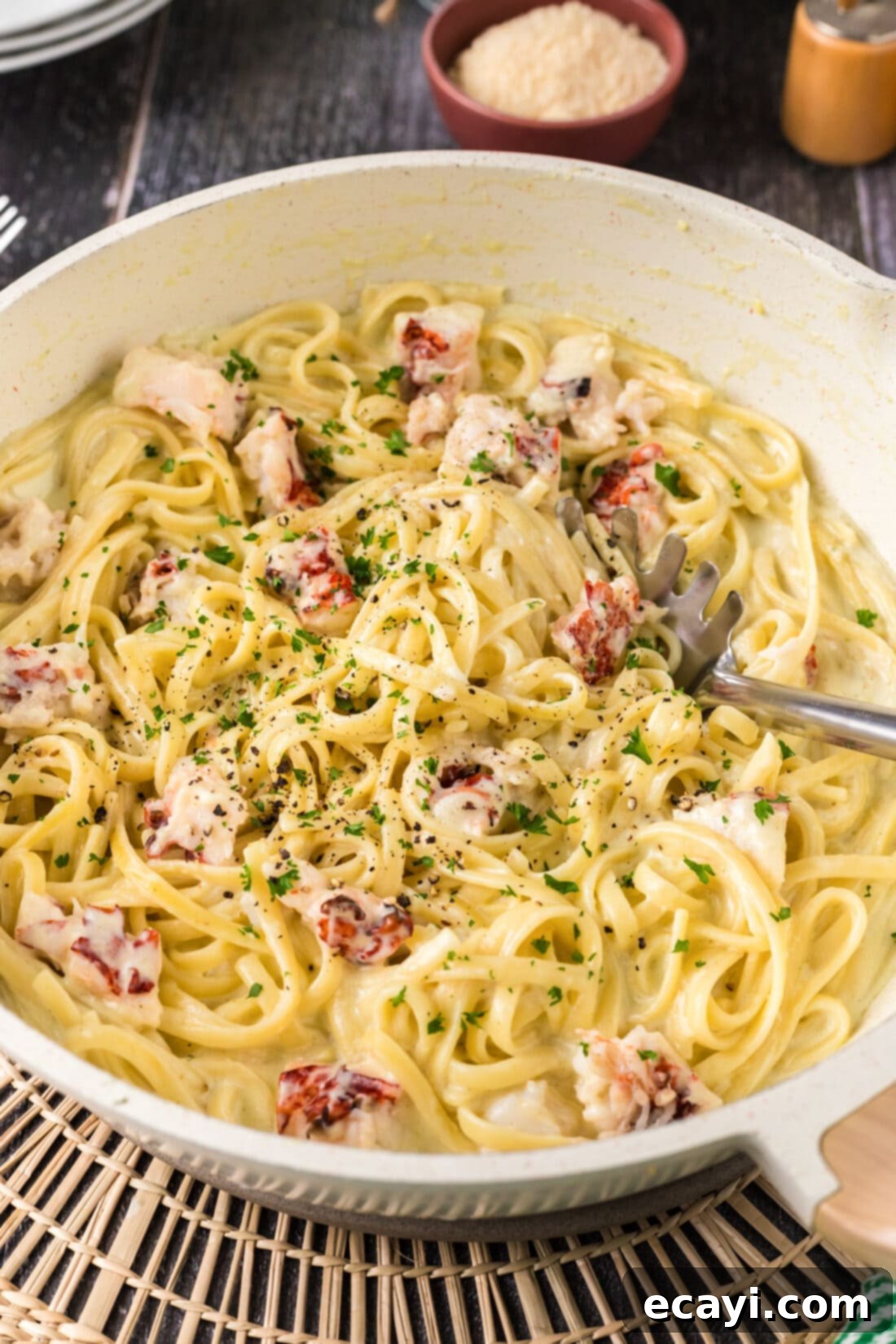
Essential Ingredients You Will Need for Lobster Pasta
Crafting the perfect lobster pasta begins with selecting high-quality ingredients. Each component plays a crucial role in building the layered flavors and luxurious texture of this dish. From the star ingredient, lobster, to the aromatic vegetables and the creamy base, attention to detail in your ingredient selection will ensure an outstanding result. Don’t worry, we’ve got you covered with detailed notes and substitution suggestions.
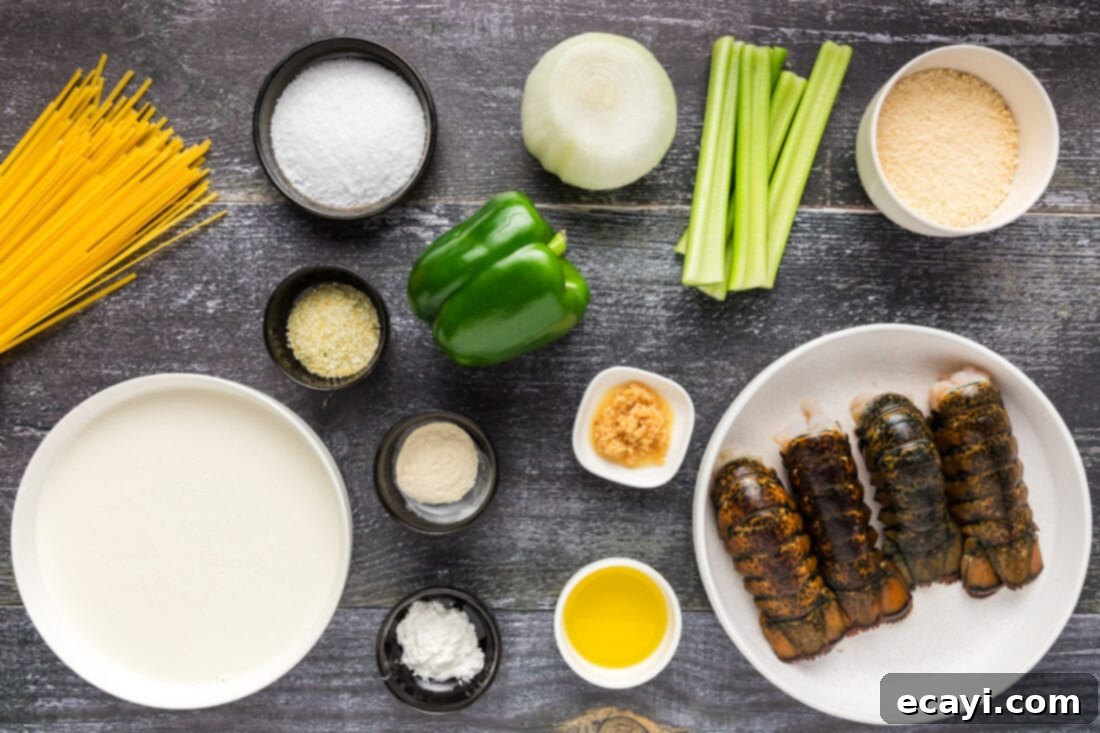
Ingredient Information and Smart Substitutions
Let’s dive deeper into the key components of this dish and discuss how to choose and prepare them for the best possible outcome:
- LOBSTER: For this recipe, we recommend using 4 lobster tails, typically about 4 ounces each, totaling 16 ounces. This provides a generous amount of succulent lobster meat per serving. However, if you desire an even more decadent portion of seafood, you can easily increase this to 6 tails. When purchasing lobster, you have a few options to consider:
- Fresh vs. Frozen: Fresh lobster tails, if readily available, will offer the absolute best flavor and tender texture. However, high-quality frozen lobster tails are an excellent and often more accessible alternative. Ensure they are fully thawed in the refrigerator overnight before use. Rapid thawing methods can sometimes affect texture.
- Already Cooked Lobster Meat: If you opt for pre-cooked lobster meat for convenience, remember to adjust your shopping list. You’ll need to purchase a good quality seafood stock separately, as you won’t be generating it from boiling raw lobster tails. Look for unsalted or low-sodium stock to maintain control over the seasoning of your sauce.
- Types of Lobster: While Maine lobster is widely popular for its sweet, tender meat and soft shell, other varieties like spiny lobster can also be used. The key is to source fresh, high-quality meat regardless of the specific type.
- PASTA: Our preferred choice for this dish is linguine due to its flat, ribbon-like shape. This design allows it to perfectly cradle the rich, creamy sauce and tender lobster chunks, ensuring a harmonious bite every time. However, the beauty of pasta is its incredible versatility. Feel free to substitute with other long pasta shapes that you enjoy:
- Angel Hair (Capellini): For a lighter, more delicate texture that won’t overpower the lobster.
- Spaghetti: A classic and universally loved alternative with a familiar mouthfeel that pairs well with many sauces.
- Fettuccine or Tagliatelle: Wider, flat noodles that are robust enough to hold the creamy sauce exceptionally well, providing a satisfying chew.
- Short Pasta: If you prefer, even a short pasta like penne or fusilli could work, though long pasta generally offers a more elegant presentation and interaction with a creamy seafood sauce.
The most important tip is to cook your chosen pasta al dente – firm to the bite. It will continue to cook slightly when combined with the hot sauce, and al dente pasta ensures it won’t become mushy.
- SAUCE BASE: The foundation of our luxurious sauce is built upon a medley of aromatic vegetables and rich cream, creating a depth of flavor that complements the lobster without overshadowing it:
- Aromatics (Onion, Celery, Bell Peppers, Garlic): These humble vegetables are sautéed to create a fragrant and flavorful base. The onion provides sweetness, celery adds a subtle earthy note, bell peppers contribute a fresh, slightly peppery crispness, and garlic offers its indispensable pungent warmth. Cooking them slowly builds complex flavor layers.
- Heavy Whipping Cream: This is undoubtedly the star ingredient for achieving that unparalleled richness and velvety texture in your sauce. Its high-fat content ensures a luscious, non-splitting sauce. For a slightly lighter version, you can substitute with half and half, though be aware that the sauce may not be quite as thick and indulgent, and may require a bit more cornstarch to achieve desired consistency. Avoid using regular milk, as it has a lower fat content and is more prone to curdling in a hot sauce.
- Seasonings (Garlic Salt and Onion Powder): These powdered forms of aromatics provide a concentrated boost of savory flavor, ensuring the sauce is seasoned perfectly and evenly throughout. Freshly ground black pepper is also a welcome addition.
- Parmesan Cheese: Freshly grated Parmesan cheese (opt for good quality for best flavor) adds a salty, umami depth and contributes significantly to the sauce’s creamy body as it melts in.
- Cornstarch Slurry: A simple mix of cornstarch and cold water acts as a highly effective thickening agent, giving the sauce its ideal consistency so it beautifully coats the pasta and lobster. This is key to preventing a watery sauce.
- Olive Oil: Used generously for sautéing the aromatics, it also helps prevent the cooked pasta from sticking together while it awaits the sauce.
How to Make This Exquisite Lobster Pasta: Step-by-Step Guide
Follow these detailed steps to create a show-stopping lobster pasta dish. The process is divided into cooking the pasta and lobster, followed by preparing the rich, creamy sauce, and finally combining all components for a truly memorable meal.
These step-by-step photos and instructions are designed to help you visualize the entire cooking process and ensure success. For a concise, printable version of this recipe, complete with precise measurements and a full ingredient list, please refer to the recipe card located at the bottom of this post.
Part 1: Preparing the Pasta and Lobster
- Cook the Pasta: Begin by cooking your chosen linguine pasta according to the package directions. It’s crucial to cook it until it is perfectly al dente. This means it should be firm to the bite but not hard, as it will continue to cook slightly when combined with the hot sauce. Once cooked, drain the pasta thoroughly using a colander. Immediately rinse it with cool water to stop the cooking process and prevent the noodles from becoming mushy or sticking together. To further ensure the noodles remain separate and pliable, toss the drained pasta with about 2 teaspoons of olive oil. Cover the pasta and set it aside while you prepare the other components.
- Prepare Lobster Tails for Cooking: Handling the lobster tails carefully, use sturdy kitchen shears to cut down the center of each lobster shell along the top, extending all the way to the tail, but being careful not to cut through the tail fan itself. This creates an opening for the meat. Next, turn the lobster over and gently loosen the meat from the shell, leaving it still attached at the head end. This “butterfly” method not only allows for more even cooking but also makes it much easier to remove the meat cleanly once cooked.

Carefully cutting the lobster shell down the center with kitchen shears, preparing it for removal. 
Gently pulling the lobster meat away from the shell, creating a butterflied appearance. 
Lobster tails butterflied and fanned out from their shells, ready for blanching. - Boil the Lobster: Fill a large stock pot two-thirds full with water. Bring it to a rapid, rolling boil over medium-high heat. Add 4 tablespoons of Kosher salt to the water and stir until it dissolves completely. The water should be very salty, mimicking seawater, as this enhances the lobster’s natural sweetness and flavor. Carefully add the prepared lobster tails to the vigorously boiling water. Cook for precisely one minute. It is important to note that there’s no need to wait for the water to return to a boil after adding the lobster. After one minute, immediately turn off the heat and leave the lobster tails in the hot water for an additional two minutes. This quick cooking method ensures perfectly tender, never rubbery, lobster meat. Overcooking lobster is the most common mistake, so timing is key here.

Lobster tails gently cooking in vigorously salted boiling water for a short duration. - Reserve Seafood Stock and Remove Lobster: Using tongs, carefully remove the cooked lobster tails from the pot and transfer them to a clean cutting board. Crucially, do NOT discard the cooking water yet! This flavorful liquid is now your homemade seafood stock, a vital and intensely flavorful component for your sauce. Measure out precisely 1 ¼ cups of this seafood stock and set it aside in a bowl or measuring cup. You can discard the remaining water or, if you wish, save and freeze it for future seafood recipes to add depth of flavor to soups, stews, or other sauces. Reserve the now-empty stock pot for a later step in making the sauce.

Perfectly cooked lobster tails resting on a cutting board, ready for meat extraction. - Chop the Lobster Meat: Once the lobster tails are cool enough to handle comfortably, proceed to remove the meat completely from their shells. The butterflied shells should make this task quite easy. Chop the tender, cooked lobster meat into bite-sized chunks. Aim for pieces that are large enough to make an impact but small enough to be easily eaten with a fork. Set these chopped lobster chunks aside; they will be gently folded into the sauce at the very end of the cooking process to maintain their delicate texture and prevent them from becoming tough or chewy.

Freshly chopped lobster meat in a bowl, prepared for its grand entrance into the creamy pasta sauce.
Crafting the Irresistible Creamy Sauce
The sauce is where the magic truly happens, transforming simple ingredients into a rich, flavorful embrace for the lobster and pasta. This creamy base is what makes the dish so utterly indulgent.
- Sauté the Aromatics: In a large, deep-sided skillet, heat 2 tablespoons of olive oil over medium-high heat until it begins to shimmer. Add the minced garlic and sauté for approximately 1 minute, or until it becomes wonderfully fragrant. Be diligent here and ensure the garlic doesn’t burn, as burnt garlic can impart a bitter taste. Next, add the chopped onion, green bell pepper, and diced celery to the skillet. Cook these vegetables for 3-4 minutes, stirring occasionally, until they begin to soften and release their aromatic flavors. This step builds the savory and sweet foundation of your sauce.

Sautéing fresh onion, bell pepper, celery, and garlic in olive oil to build the sauce’s aromatic base. - Build the Flavor Base with Liquids: Once the vegetables are softened, sprinkle in the garlic salt and onion powder. Stir these seasonings thoroughly to combine them with the sautéed vegetables, ensuring even distribution of flavor. Next, carefully pour in the reserved 1 ¼ cups of seafood stock (the flavorful water from boiling your lobster) and the 1 ½ cups of heavy whipping cream into the skillet. Stir everything together until all ingredients are well combined, then increase the heat slightly and bring the mixture to a gentle boil. This step integrates the key liquid components and begins to thicken the sauce.

Seasoning the sautéed vegetables with garlic salt and onion powder. 
The colorful mixture of sautéed vegetables, forming the delicious base of the sauce. 
Pouring heavy cream into the skillet, beginning to transform the vegetables into a rich, creamy sauce. - Achieve a Smooth Consistency (Optional but Recommended): Once the sauce mixture reaches a boil, reduce the heat to a simmer. For an exceptionally smooth, restaurant-quality sauce, use an immersion blender to carefully blend the sauce directly in the skillet, breaking down any large vegetable chunks until the sauce is as silky and smooth as you desire. Alternatively, you can carefully transfer the hot sauce to a standard blender (using caution when blending hot liquids, only filling it halfway and venting the lid). After blending, turn off the heat. Place a colander over the empty stock pot (or a clean, heat-proof bowl) and strain the sauce through it to remove any remaining vegetable solids. This extra step, while optional, is highly recommended for achieving an ultra-silky, professional-grade sauce texture.

Using an immersion blender to create a perfectly smooth and uniform sauce consistency. 
Straining the blended sauce through a colander for an extra-silky, refined finish. - Add Parmesan Cheese: Pour the strained (or un-strained, if you skipped that step) sauce back into the clean stock pot. Place the pot over medium-high heat. Whisk in the ¼ cup of grated Parmesan cheese until it is fully melted and thoroughly incorporated into the sauce. The Parmesan adds another layer of savory richness and contributes to the overall creamy texture, enhancing the luxurious feel of the dish.

Whisking freshly grated Parmesan cheese into the simmering sauce, adding depth and creaminess. - Thicken the Sauce to Perfection: In a small separate bowl, whisk together the 2 teaspoons of cornstarch with ¼ cup of cold water until a smooth, lump-free slurry is formed. This is your thickening agent. Add this cornstarch slurry to the simmering sauce in the stock pot, whisking constantly and vigorously to prevent any lumps from forming. Bring the sauce back to a boil, then immediately reduce the heat to a gentle simmer. Continue to simmer for 10-15 minutes, stirring occasionally, until the sauce thickens to your desired consistency – it should be thick enough to beautifully coat the back of a spoon and cling to pasta without being overly heavy.

Adding the cornstarch slurry to the sauce and whisking to ensure smooth thickening. - Combine and Serve: Finally, add the cooked and drained linguine noodles to the thickened, creamy sauce in the stock pot. Gently toss the pasta using tongs or a large spoon to ensure every strand is evenly coated with the luscious sauce. Then, carefully fold in the chopped lobster chunks. Heat through for just a minute or two, stirring gently, ensuring the lobster is warmed but not overcooked, which could make it tough. Overheating the lobster at this stage will compromise its tender texture. Serve immediately in warm bowls, garnished with fresh parsley or chives if desired for a touch of color and freshness.

The perfectly combined linguine noodles and lobster chunks enveloped in the creamy sauce, ready to be enjoyed.
Frequently Asked Questions & Expert Tips for Perfect Lobster Pasta
To maintain optimal freshness and flavor, store any leftover lobster pasta in an airtight container. Keep it refrigerated promptly after cooling. It will remain delicious for up to 3 days. For best results, allow the pasta to cool completely on the counter (no longer than 2 hours) before transferring it to the container. This prevents condensation from building up inside the container, which can make the pasta soggy.
When reheating, gentle warming is key to preserving the lobster’s tender texture. You can gently warm the pasta in a skillet over medium-low heat, stirring occasionally, until it is heated through. This method allows for more control. Alternatively, you can use a microwave, heating in short 30-60 second bursts and stirring between each interval to ensure even reheating. Be mindful not to overcook the lobster, as it can become tough and rubbery. If the sauce appears too thick or dry after refrigeration, add a splash of water, milk, or a bit more heavy whipping cream to remoisten it and bring back its original creamy consistency.
Absolutely! To streamline your cooking process, you can prepare several components in advance. The lobster tails can be cooked and chopped, then stored covered in the refrigerator for up to 24 hours. Similarly, all the vegetables for the sauce can be chopped a day ahead. The creamy sauce itself can be made completely and stored in an airtight container in the refrigerator for up to 2 days. When ready to serve, gently reheat the sauce, cook fresh pasta, and combine with the prepped lobster and sauce for a quick, luxurious meal.
While linguine is a fantastic traditional choice, this creamy sauce pairs beautifully with other long pasta shapes that can hold the sauce well. Consider tagliatelle or pappardelle for a heartier noodle, or even thin spaghetti for a slightly lighter feel. If you prefer short pasta, rigatoni or fusilli can also work, as their shapes allow them to capture the creamy sauce in their ridges and spirals. Experiment to find your favorite!
Yes, this recipe is highly adaptable! To add more nutrients, color, and flavor, consider folding in some fresh baby spinach or arugula at the very end, allowing it to wilt gently into the hot pasta. Halved cherry tomatoes could also add a touch of acidity and brightness, offering a lovely counterpoint to the richness of the sauce. Sautéed mushrooms, asparagus tips, or even a handful of green peas would also make delicious and visually appealing additions.
The key to tender lobster is precise cooking time. Follow the instructions carefully: boil for just one minute, then let it rest in the hot water for two minutes with the heat off. This gentle cooking method ensures the lobster is perfectly cooked through without becoming tough. Also, when combining with the sauce, only warm the lobster chunks briefly, avoiding prolonged cooking.
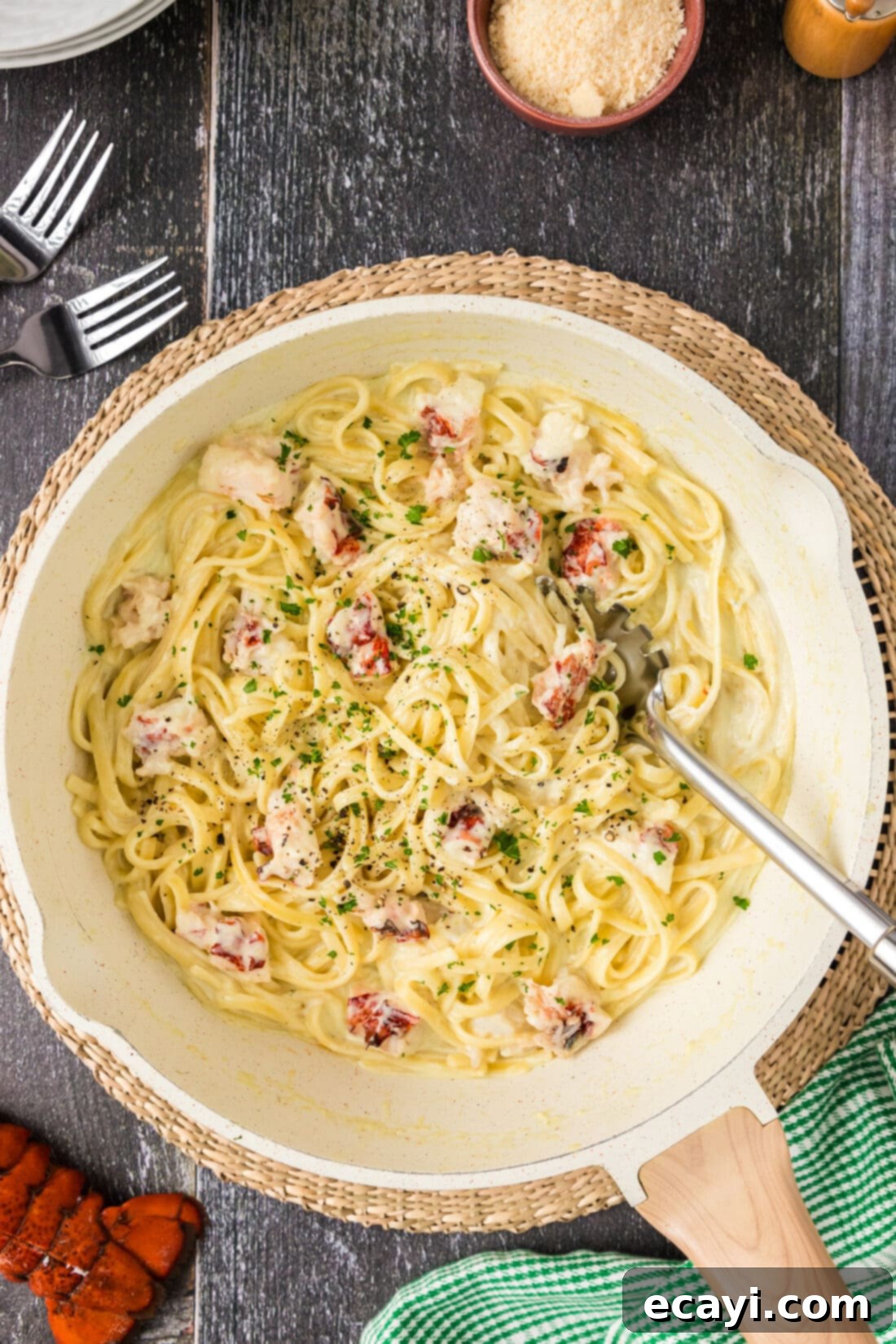
Serving Suggestions to Enhance Your Gourmet Meal
To fully complete your gourmet lobster pasta experience, consider these delightful serving accompaniments and garnishes. They will elevate the meal and provide a balanced culinary journey:
- Crusty Bread or Garlic Bread: A freshly baked, crusty baguette or warm, buttery garlic bread is an absolute must-have. It’s perfect for soaking up every last drop of that incredible, flavorful creamy sauce. Homemade garlic bread especially takes this pairing up a notch.
- Fresh Green Salad: A light, crisp leafy dinner salad provides a refreshing contrast to the richness of the pasta. Think a simple garden salad with a bright vinaigrette, a peppery arugula salad, or a classic Caesar salad. This helps balance the meal and adds a fresh element.
- Wine Pairing: Complement the delicate sweetness of the seafood and the richness of the creamy sauce with a crisp, dry white wine. Excellent choices include a dry Pinot Grigio, a vibrant Sauvignon Blanc, or a lightly oaked Chardonnay. These wines will cleanse the palate and enhance the flavors of the dish.
- Garnish: Finish each serving with a generous sprinkle of freshly chopped parsley or chives. Not only does this add a beautiful pop of vibrant green color, but it also provides a burst of fresh, herbaceous flavor that brightens the entire dish.
- Lemon Wedges: Offer lemon wedges on the side for those who appreciate a bright, zesty counterpoint to rich seafood dishes. A squeeze of fresh lemon juice just before eating can lift the flavors beautifully.
More Delicious Related Seafood Recipes to Try
If you loved crafting and enjoying this decadent lobster pasta, you might find joy in exploring other fantastic seafood pasta dishes and indulgent seafood creations from our kitchen:
- Creamy Garlic Shrimp Pasta: A quick and flavorful alternative using plump shrimp.
- Seared Scallop Pasta with Lemon Butter Sauce: Elegant and easy, highlighting the sweetness of scallops.
- Classic Shrimp Scampi with Linguine: A timeless dish bursting with garlic and butter flavor.
- Decadent Lobster Mac and Cheese: The ultimate comfort food elevated with luxurious lobster.
- Flaky Salmon Pasta with Dill: A healthy and flavorful pasta dish featuring perfectly cooked salmon.
I genuinely love sharing my passion for baking and cooking, and bringing my kitchen experiences directly to you! To make sure you never miss a new recipe or expert tip, consider subscribing to my convenient newsletter. Simply subscribe here and start receiving free daily recipes right to your inbox!
Lobster Pasta Recipe
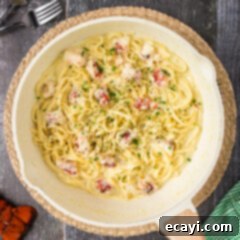
This recipe delivers a decadent creamy sauce that perfectly complements tender chunks of cooked lobster meat, creating an unforgettable pasta dish that feels gourmet but is surprisingly easy to make at home. Rated 5 stars from 4 votes.
Recipe Overview
- Course: Dinner
- Cuisine: American, Seafood
- Yields: 4 servings (approximately 7 ½ cups total)
- Prep time: 15 minutes
- Cook time: 25 minutes
- Total time: 40 minutes
- Calories: 644 per serving
- Author: Amanda Davis
Ingredients
For the Pasta and Lobster:
- ½ pound linguine pasta (8 ounces)
- 16 ounces lobster tail (Four 4-ounce lobster tails)
- 4 Tablespoons Kosher salt (for boiling lobster)
- 2 teaspoons olive oil (for tossing pasta)
For the Creamy Sauce:
- 2 Tablespoons olive oil
- ½ Tablespoon minced garlic
- ¼ cup chopped onion
- 2 stalks celery, trimmed and diced
- ½ green bell pepper, diced
- ½ Tablespoon garlic salt
- 1 ½ teaspoons onion powder
- 1 ¼ cups reserved seafood stock (from boiling lobster)
- 1 ½ cups heavy whipping cream
- ¼ cup grated Parmesan cheese
- 2 teaspoons cornstarch
- ¼ cup cold water (for slurry)
Equipment You’ll Need
- Large Stockpot
- Large Deep-Sided Skillet
- Kitchen Shears
- Tongs
- Immersion Blender (optional, for smoother sauce)
- Colander
- Cutting Board
- Whisk
Instructions
- Prepare Pasta: Cook linguine pasta according to package directions until al dente. Drain, rinse with cool water to stop cooking, and toss with 2 teaspoons of olive oil to prevent sticking. Cover and set aside.
- Prepare Lobster Tails: Using kitchen shears, cut down the center of each lobster shell to the tail (do not cut the tail fan). Turn lobster over and gently loosen the meat from the shell, leaving it connected near the head end.
- Boil Lobster: Fill a stock pot two-thirds full with water and bring to a rolling boil over medium-high heat. Add 4 Tablespoons of Kosher salt and stir. Add lobster tails to the boiling water, cook for 1 minute. Turn off heat and leave in water for 2 minutes.
- Reserve Stock & Remove Meat: Use tongs to remove lobster tails to a cutting board. Reserve 1 ¼ cups of the cooking water (seafood stock). Discard (or save/freeze) the remaining water. Save the stock pot.
- Chop Lobster: Remove meat from shells and chop into bite-sized chunks. Set aside.
- Sauté Aromatics: Heat 2 Tablespoons olive oil in a deep-sided skillet over medium-high heat until shimmering. Add ½ Tablespoon minced garlic and sauté for 1 minute until fragrant. Add ¼ cup chopped onion, 2 diced celery stalks, and ½ diced green bell pepper. Cook for 3-4 minutes until softened.
- Simmer Sauce Base: Sprinkle in ½ Tablespoon garlic salt and 1 ½ teaspoons onion powder; stir to combine. Add the reserved 1 ¼ cups seafood stock and 1 ½ cups heavy whipping cream to the skillet. Stir together and bring to a boil.
- Blend and Strain (Optional for Smoothness): Reduce heat to a simmer. Use an immersion blender to break down large vegetable chunks for a smoother sauce. Turn off heat. Place a colander over the empty stock pot and strain the sauce to remove vegetable chunks (highly recommended for a silky sauce).
- Add Cheese: Return the strained sauce to the stock pot over medium-high heat. Whisk in ¼ cup grated Parmesan cheese until fully incorporated.
- Thicken Sauce: In a small bowl, whisk 2 teaspoons cornstarch with ¼ cup cold water to create a slurry. Add the slurry to the sauce in the stock pot, whisking constantly. Bring to a boil, then reduce to a simmer. Simmer for 10-15 minutes, stirring occasionally, until the sauce thickens.
- Combine and Serve: Add the cooked linguine noodles to the sauce, tossing to coat. Gently fold in the chopped lobster chunks and heat through for 1-2 minutes. Serve immediately, garnished with fresh parsley if desired.
Nutrition Information (per serving, approximate)
- Serving Size: 1 serving (approx. 2 cups)
- Calories: 644 cal
- Carbohydrates: 50g
- Protein: 18g
- Fat: 42g
- Saturated Fat: 23g
- Polyunsaturated Fat: 3g
- Monounsaturated Fat: 14g
- Trans Fat: 0.003g
- Cholesterol: 147mg
- Sodium: 2034mg
- Potassium: 391mg
- Fiber: 3g
- Sugar: 5g
- Vitamin A: 1512 IU
- Vitamin C: 14mg
- Calcium: 171mg
- Iron: 1mg
The recipes on this blog are tested with a conventional gas oven and gas stovetop. It’s important to note that some ovens, especially as they age, can cook and bake inconsistently. Using an inexpensive oven thermometer can assure you that your oven is truly heating to the proper temperature. If you use a toaster oven or countertop oven, please keep in mind that they may not distribute heat the same as a conventional full sized oven and you may need to adjust your cooking/baking times. In the case of recipes made with a pressure cooker, air fryer, slow cooker, or other appliance, a link to the appliances we use is listed within each respective recipe. For baking recipes where measurements are given by weight, please note that results may not be the same if cups are used instead, and we can’t guarantee success with that method.
